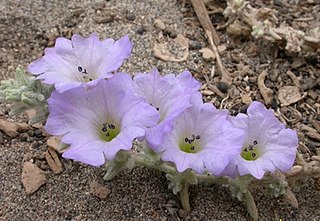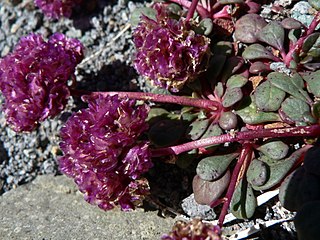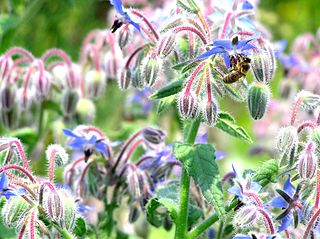
Boraginaceae, the borage or forget-me-notfamily, includes about 2,000 species of shrubs, trees, and herbs in 146 to 154 genera with a worldwide distribution.

Lithospermum is a genus of plants belonging to the family Boraginaceae. The genus is distributed nearly worldwide, but most are native to the Americas and the center of diversity is in the southwestern United States and Mexico. Species are known generally as gromwells or stoneseeds.

Hackelia (stickseeds) is a genus of plants in the borage family, Boraginaceae. It includes 54 species found in North America, western South America, temperate Eurasia, and Australia. 12 species are native to California.

Nolana is a genus of hard annual or perennial plants in the nightshade family. The genus is mostly native to Chile and Peru. Species in this genus, especially N. paradoxa, serve as a model system for studies on flower color.

Cistanthe is a plant genus which includes most plants known as pussypaws. These are small, succulent flowering plants which often bear brightly colored flowers, though they vary quite a bit between species in appearance. Some species have flowers that are tightly packed into fluffy-looking inflorescences, the trait that gives them their common name.

Plagiobothrys is a genus of flowering plants known commonly as popcorn flowers. These are small herbaceous plants which bear tiny white or yellow flowers. Their fruits are nutlets. Although these plants are found predominantly in North America and South America, five species are known from Australia. Of the approximately 65 species described, more than 15 are endemic to California.

Euplassa is a genus of flowering plants in the protea family. It is native to tropical South America, including Bolivia, Brazil, Colombia, Ecuador, French Guiana, Guyana, Peru, Suriname, and Venezuela.

Pectocarya is a plant genus of about 15 species in the family Boraginaceae. Plants in this genus are known generally as combseeds. They are small annual plants which bear tiny white flowers no more than 3 millimeters in diameter. Their fruits are nutlets which often have small projections that look like the teeth of a comb, hence their common name. The nutlets usually come in clusters of four. These plants are found mainly in western North America.

I. M. Johnston, was a United States botanist. He studied at Pomona College in Claremont, California and at Harvard University. His plant collections are housed in the Rancho Santa Ana Botanic Garden, in Claremont, and also in the Gray Herbarium of Harvard University.

Boraginoideae is a subfamily of the plant family Boraginaceae s.s, with about 42 genera. That family is defined in a much broader sense in the Angiosperm Phylogeny Group (APG) system of classification for flowering plants. The APG has not specified any subfamilial structure within Boraginaceae s.l.

Eritrichium is a genus of flowering plants in the family Boraginaceae. It contains 78 species. Notable members include Eritrichium howardii and Eritrichium nanum.

Euploca is an almost cosmopolitan genus of plants with 168 species. It was first described by Thomas Nuttall in 1837. While part of the broadly defined Boraginaceae in the APG IV system from 2016, a revision of the order Boraginales from the same year includes Euploca in the separate family Heliotropiaceae. Its species used to be classified in the genera Hilgeria and Schleidenia and in Heliotropium sect. Orthostachys, but were found to form an independent lineage in a molecular phylogenetic analysis, more closely related to Myriopus than to Heliotropium. While many species use the C4 photosynthetic pathway, there are also C3–C4 intermediate species. Species have leaves with a C4-typical Kranz anatomy.

Varronia is a genus of flowering plants in the family Boraginaceae, found throughout Latin America, the Caribbean, and in the US states of Texas and Florida. They were resurrected from Cordia in 2007.
Tarasa is a genus of flowering plants belonging to the family Malvaceae.
Antiphytum, commonly known as saucerflower, is a genus of flowering plants belonging to the family Boraginaceae.

Echiochilon is a genus of flowering plants belonging to the family Boraginaceae.
Moritzia is a genus of flowering plants belonging to the family Boraginaceae.
Lasiocaryum is a genus of flowering plants belonging to the family Boraginaceae.












